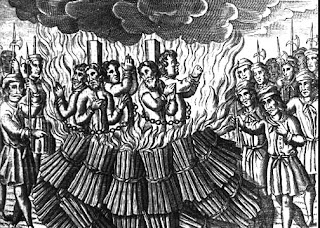Much of the medieval attitude about music and its forms came from Boethius (c.480-524 CE). In his de institution music [Latin: "On the laws of music"] he distinguished three types of music:
Although today we use the word "mundane" to refer to something ordinary, it comes from Latin and refers to the world; Boethius uses it to refer to the music made by the world, that is, the so-called "music of the spheres": that sound, inaudible to human ears, that was made by the friction of the spheres surrounding the Earth in which the planets and other heavenly bodies traveled.
Instrumental music referred to music made by one of several different agents. It could come from something under tension (such as with stringed instruments), by wind, by water, or by percussion. It should be noted that Boethius was not referring to "musical instruments" as much as he used the term to mean that some physical agency was causing the sound. That could be a rushing stream, the wind in the trees, and falling rocks as much as manufactured devices in the hands of a musician. Later writers included singing as part of this category.
Human music was therefore not referring to singing by humans. For the Middle Ages, "music" was all about harmony, and the "harmony" between the physical body and the spiritual side was a serious topic. For example, you must nourish the physical body, but you must not eat so much that you fall into the sin of gluttony. Proper proportion was everything.
In fact, music (as opposed to mere noise) was all about harmony and proportion. That is why Music was studied in the medieval university only after mastering Arithmetic. A contemporary of Boethius, Cassiodorus (485-c.585 CE), compared the two by explaining that
Instrumental music
Human music
Mundane music
 |
| Detail from copy of De musica [source] |
Instrumental music referred to music made by one of several different agents. It could come from something under tension (such as with stringed instruments), by wind, by water, or by percussion. It should be noted that Boethius was not referring to "musical instruments" as much as he used the term to mean that some physical agency was causing the sound. That could be a rushing stream, the wind in the trees, and falling rocks as much as manufactured devices in the hands of a musician. Later writers included singing as part of this category.
Human music was therefore not referring to singing by humans. For the Middle Ages, "music" was all about harmony, and the "harmony" between the physical body and the spiritual side was a serious topic. For example, you must nourish the physical body, but you must not eat so much that you fall into the sin of gluttony. Proper proportion was everything.
In fact, music (as opposed to mere noise) was all about harmony and proportion. That is why Music was studied in the medieval university only after mastering Arithmetic. A contemporary of Boethius, Cassiodorus (485-c.585 CE), compared the two by explaining that
Arithmetic is the discipline of absolute numerable quantity. Music is the discipline which treats of numbers in their relation to those things which are found in sound.














